Afghanistan–China border
The border between Afghanistan and China is a 76-kilometre-long (47 mi)[1] boundary, beginning at the tripoint of both countries with Pakistan administrated region of Kashmir (Gilgit-Baltistan), following the watershed along the Mustagh Range, and ending at the tripoint with Tajikistan. This short border is in the far northeast of Afghanistan, distant from much of the country or urban areas, at the end of the Wakhan Corridor. The Chinese side of the border is located in the Chalachigu Valley. Both sides of the border are nature reserves: Wakhan Corridor Nature Refuge in Wakhan District, Badakhshan Province on the Afghan side and Taxkorgan Nature Reserve in Taxkorgan Tajik Autonomous County, Kashgar Prefecture, Xinjiang Uygur Autonomous Region on the Chinese side. The border is crossed by several mountain passes including Wakhjir Pass in the south and Tegermansu Pass in the north.
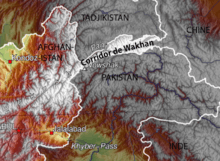
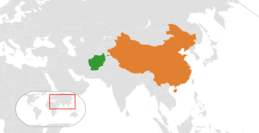
The border marks the greatest terrestrial time zone difference on Earth, with a 3.5 hour difference between Afghanistan's UTC+4:30 and China's UTC+08:00.[2]
History
The border area was a thoroughfare on the Silk Road. It is believed that the famous Chinese Buddhist pilgrim Xuanzang traveled this pass on his return trip back to China around 649 AD.[3]
The border was established between Afghanistan and China in an agreement between the British and the Russians in 1895 as part of the Great Game, although the Chinese and Afghans did not finally agree on the border until 1963.[4][5] The Kingdom of Afghanistan and the People's Republic of China demarcated their border in 1963.[4][6]
It is believed that in more recent times, the main pass, Wakhjir Pass, is sometimes used as a low intensity drug smuggling route, and is used to transport opium made in Afghanistan to China.[7] In the 2000s, Afghanistan has asked China on several occasions to open the border in the Wakhan Corridor for economic reasons or as an alternative supply route for fighting the Taliban insurgency. However, China has resisted, largely due to unrest in its far western province of Xinjiang, which borders the corridor.[8][9] In December 2009, it was reported that the United States had asked China to open the corridor.[10]
There have been proposals and plans by Kashgar regional government to open Tegermansu Pass as a port of entry for economic purposes since the 1990s.[11][12] However, this has yet to happen.
Geography
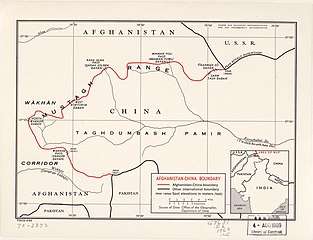
Article 1 of the 1963 treaty describes the Afghanistan–China border, starting from the southern end:
starting from a peak with a height of 5,630 meters--the reference coordinates of which are approximately 37 degrees 03 minutes north, 74 degrees 36 minutes east in the southern extremity, the boundary line between the two countries runs along the Mustagh Range watershed between the Karachukur Su River, a tributary of the Tashkurghan River, on the one hand, and the sources of the Aksu River and the Wakhjir River, the upper reaches of the Wakhan River, on the other hand, passing through South Wakhjir Daban (Called Wakhjir Pass on the Afghan map) at the elevation of 4,923 meters, North Wakhjir Daban (named on the Chinese map only), West Koktorok Daban (named on the Chinese map only), East Koktorok Daban (called Kara Jilga Pass on the Afghan Map), Tok Man Su Daban (called Mihman Yoli Pass on the Afghan map), Sirik Tash Daban (named on the Chinese map only), Kokrash Kol Daban (called Tigarman Su Pass on the Afghan map) and reaches Peak Kokrash Kol (called Peak Povalo Shveikovski on the Afghan map) with a height of 5,698 meters.
The border's northern terminus is found at the Afghanistan-China-Tajikistan tripoint on Povalo-Shveikovskogo Peak[13][14] (Chinese: 波万洛什维科夫斯基峰[15]; pinyin: Bōwànluò Shíwéikēfūsījī Fēng) / Kokrash Kol Peak (Kekelaqukaole Peak; Chinese: 克克拉去考勒峰[16]; pinyin: Kèkèlāqùkǎolè Fēng),[1][17] the easternmost point of Afghanistan.
Border crossings
Historically, the main crossing between the two sides was Wakhjir Pass. Wakhjir Pass has been in use for at least a millennium since the Silk Road. In addition to Wakhjir Pass, there is also Tegermansu Pass which is located on the far eastern end from Little Pamir.
The passes are closed as Chalachigu Valley, the valley on the Chinese side, is closed to visitors; however, local residents and herders from the area are permitted to access.[18]
Historical maps and gallery
Historical English-language maps of the Afghanistan–China border, mid to late 20th century:
_p61_PLATE19._SINKIANG_(14597194848).jpg) Map including the Afghanistan–China border (1917)
Map including the Afghanistan–China border (1917)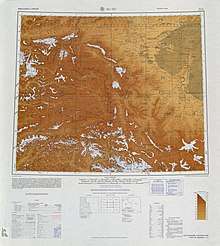
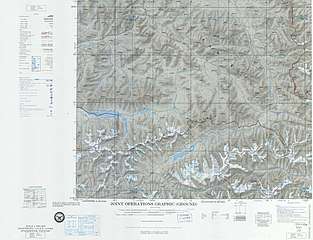 Map including Afghanistan–China border (ACIC, 1969)
Map including Afghanistan–China border (ACIC, 1969) Border region (DMA, 1980)[lower-alpha 3]
Border region (DMA, 1980)[lower-alpha 3]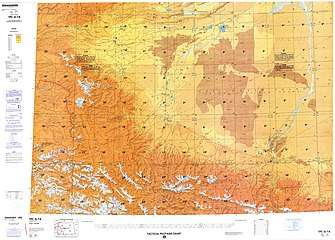 Border region (DMA, 1984)[lower-alpha 4]
Border region (DMA, 1984)[lower-alpha 4]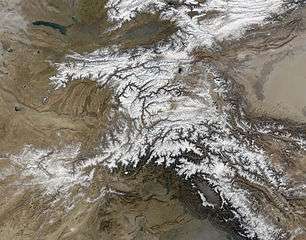 Satellite image of the region with the Afghanistan–China border marked
Satellite image of the region with the Afghanistan–China border marked_Corridor.jpg) Wakhan Corridor including Afghanistan–China border
Wakhan Corridor including Afghanistan–China border
Notes
- From map: "NAMES AND BOUNDARY REPRESENTATION ARE NOT NECESSARILY AUTHORITATIVE"
- From map: "DELINEATION OF INTERNATIONAL BOUNDARIES MUST NOT BE CONSIDERED AUTHORITATIVE"
- From map: "The representation of international boundaries is not necessarily authoritative."
- From map: "The representation of international boundaries is not necessarily authoritative"
References
- Thomas L. Hughes (14 January 1964). "THE AFGHANISTAN - CHINA BOUNDARY SETTLEMENT" (PDF). Bureau of Intelligence and Research. pp. 1, 4. Retrieved 12 January 2020 – via CIA.
The new boundary, 47 miles long,{...}and reaches Peak Kokrash Kol (called Peak Povalo Shveikovski on the Afghan map) with a height of 5,698 meters.
- Bill Bostock (27 June 2019). "Afghanistan shares a tiny 46-mile border with China — here's the intriguing story of how the 2 countries became neighbors". Insider Inc. – via CIA.
- Stein, M. Aurel (1903-06-30). "Exploration in Chinese Turkestan". United States Congressional Serial Set. No. 748. Washington, D.C.: Smithsonian Institution. p. 752. Retrieved 2017-02-03.
- [Afghanistan-China Border Agreement] (in Chinese). 1963-11-22 – via Wikisource.
- Office of the Geographer (1969-05-01). "International Boundary Study - Afghanistan – China Boundary" (PDF). web.archive.org. Bureau of Intelligence and Research. Archived from the original (PDF) on 2015-01-03. Retrieved 2017-02-03.
The Afghanistan–China boundary agreement, signed on November 22, 1963, was the fifth of these boundaries treaties initiated by the Chinese communists.
- "Archived copy" 全国人民代表大会常务委员会关于签订中华人民共和国和阿富汗王国边界条约的决议 (in Chinese). National People's Congress. Archived from the original on 17 October 2013. Retrieved 12 January 2020.CS1 maint: archived copy as title (link)
- "Afghanistan border crossings". Caravanistan. Retrieved 2017-02-03.
It is mostly used as a low-intensity drug-smuggling corridor to bring opium to China during the summer.
- Afghanistan tells China to open Wakhan corridor route. The Hindu. June 11, 2009 Archived January 8, 2011, at the Wayback Machine
- China mulls Afghan border request. BBC News Online. June 12, 2009
- South Asia Analysis Group: Paper No. 3579, 31 December 2009 Archived June 13, 2010, at the Wayback Machine
- "新疆对外开放口岸一览表". china.com.cn (in Chinese). Retrieved 23 December 2019.
国别:阿富汗 口岸名称:托克满苏 开放时间:未定 说明:规划开放口岸(98年) Country: Afghanistan, Name of port: Tegermansu, Opening date: Undecided, Notes: Planning to open the port (1998)
- 喀什地区发展和改革委员会 (Kashgar Region Development and Reform Committee) (2016-03-17). "喀什地区国民经济和社会发展第十三个五年" [Kashgar Regional Economic and Social Development 13th Five-Year Plan (2016-2020)]. Retrieved 23 December 2019.
推进新建中国-阿富汗托克满苏陆路口岸、中国-巴基斯坦铁路口岸、中国-塔吉克斯坦铁路口岸。改善现有口岸通关条件。
- Kamoludin Abdullaev (2018). Historical Dictionary of Tajikistan (3 ed.). Rowman & Littlefield. p. 92. ISBN 9781538102527 – via Google Books.
CHINA-TAJIK BORDER.{...}This mountainous boundary runs along the Sarikol mountain range in eastern Tajikistan, reaching in Pamir the Afghan border at the Povalo-Shveikovskogo peak (5,543 meters above sea level).
- "NJ 43 Su-fu [U.S.S.R., China, Afghanistan, Pakistan, State of Jammu and Kashmir] Series 1301, Edition 5-AMS". Washington, D. C.: Army Map Service. March 1967 – via Perry–Castañeda Library Map Collection.
Pik Povalo-Shveikovskogo
- 中华人民共和国和阿富汗王国边界条约 (in Chinese). 22 November 1963 – via Wikisource.
到高程为5698米的克克拉去考勒峰(阿方图称波万洛什维科夫斯基峰)。
- 阿富汗 (in Chinese). State Ethnic Affairs Commission. 6 July 2004. Archived from the original on 4 December 2008.
中阿边界{...}南起中、巴、阿3国交界处的5587山峰,沿穆斯塔格山脉分水岭北行至克克拉去考勒峰。
- "China Report Political, Sociological and Military Affaris No. 363" (PDF). United States Joint Publications Research Service. 18 November 1982. p. 1. Retrieved 11 January 2020 – via Defense Technical Information Center.
If we open up the Atlas of the People's Republic of China we will find that the region of the Pamir, the western extremity of Xinjiang, from the Wuzibieli [Uzbel] Pass1 to the south down to the Kekelaqukaole Peak (which the Soviet Russians call "Pavel Shveikovsky Peak") is designated as a not limited area.
- 环球时报 (2009-05-07). "《环球时报》记者组在瓦罕走廊感受中国边防". china.huanqiu.com (in Chinese). Global Times. Retrieved 2017-02-04.
由于瓦罕走廊没有开放旅游,普通游客走到这里便无法继续前行。...据他介绍,该派出所海拔3900米,辖区内户籍75户,约300人,到七八月夏季牧场开放时,山下牧民会到高海拔地区放牧,走廊人口将达到1800人左右。
Further reading
| Wikimedia Commons has media related to Afghanistan-China border. |
| Wikisource has original text related to this article: |